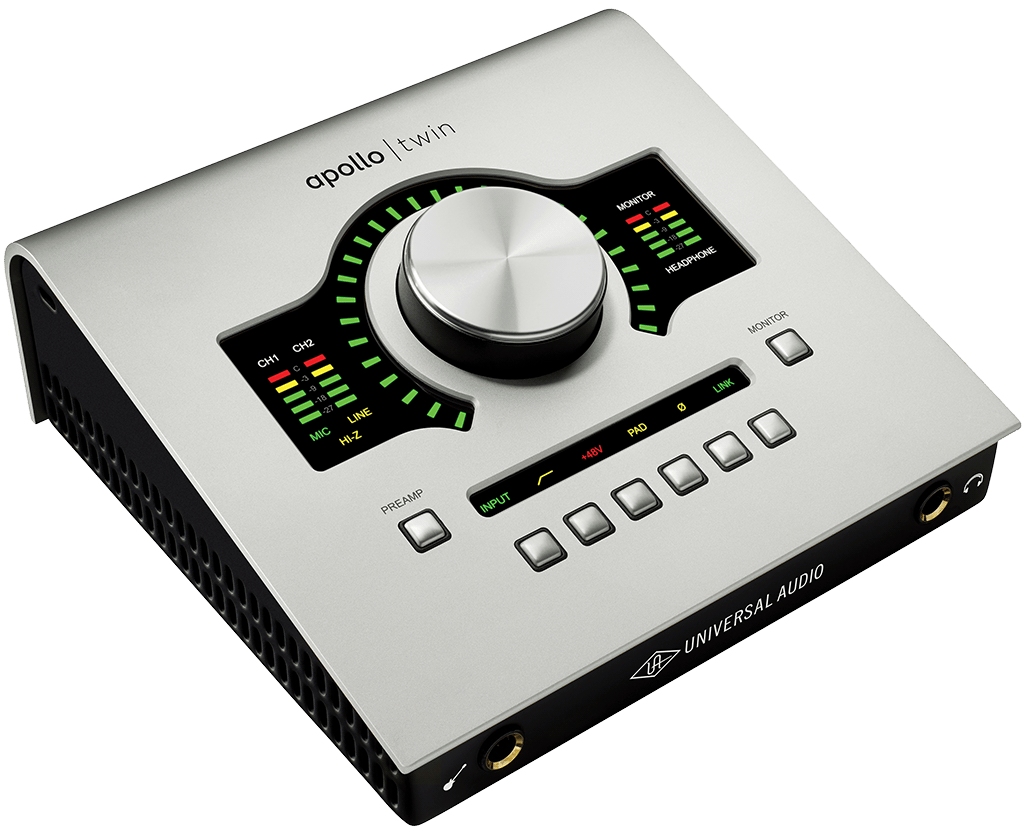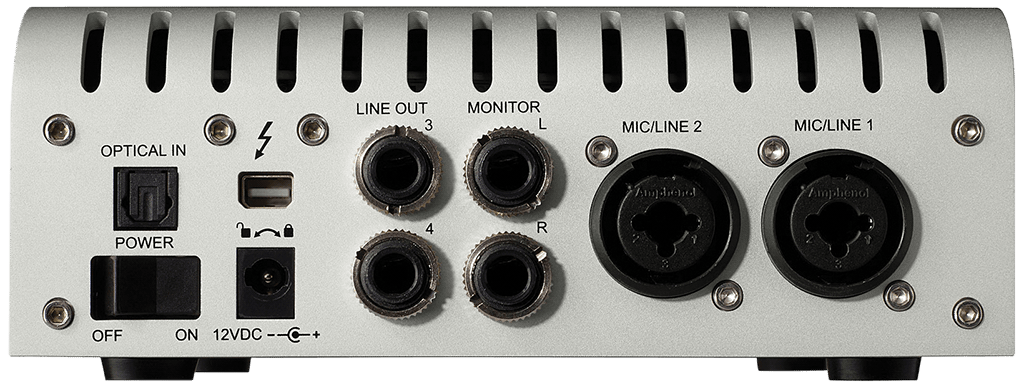
Review: Universal Audio Apollo Twin Interface
The Twin’s Unison preamp modelling puts API and vintage UA on your desktop.
It’s one of those ‘how long is a piece of string’ questions, when someone asks you which interface they should buy. I’ve been getting asked that a lot lately. And often the prerequisite features are somewhat simple: a couple of mic preamps, headphone and monitor outputs, and a DI input. Everything else is icing on the cake, or wishful thinking. I mean, it would be nice to have eight preamps onboard, but how often do you realistically record live drums in your bedroom? Or have the mics to do it?
Two-channel interfaces have been around for a while, but a few years ago, the idea of the desktop interface really came to the fore. It made little sense to keep the rack-style form factor, even half-rack, when most users were going to be sitting at a desk with little more than the interface, a laptop and couple of monitors. Why not make it ergonomic and put the knobs on the top? Voila, a whole market sector was born.
The Apollo Twin is the next generation of those units. It’s a similar idea, but with plenty of updates. Firstly, it’s a Thunderbolt device. Why? Because it also has onboard UAD Solo or Duo DSP. And, because it launched in conjunction with the debut of UAD’s Unison preamp modelling technology, you also get a model of the Universal Audio 610 tube preamp thrown in too — that’s good value.
BOLT OUT OF THE BOX
The single most annoying thing about the Twin, and possibly my only gripe, is it doesn’t ship with a Thunderbolt cable. I get that it’s not the cheapest cord going. But you’re also not likely to have one simply lying around. A trip to the store, $50 later, and we’re in business.
The lack of cables can sometimes be a good thing though. Unlike other high-quality desktop interfaces from the likes of Apogee (Duet, not Quartet) and RME, the Twin doesn’t use a breakout cable for all its interconnects — it’s all jacks on the back. I like this, it’s less load on a single point of failure, and it just feels better to snap things in and out of a back plate than the end of a snake.
Despite the missing Thunderbolt cable, the Twin is the first time UA has made full use of the Thunderbolt PCIe spec in an Apollo device. The rest have been operating on Firewire drivers, even despite the availability of optional Thunderbolt cards. This will be rectified in the coming months with a firmware update. But for now, you can only enjoy the full bandwidth of Thunderbolt with the Twin. And for those thinking about cascading multiple units or integrating the Twin with other Apollo units (perhaps as a matching Big Knob) well, that falls under the ‘not yet’ category too, though it doesn’t seem to be an issue with UAD Firewire Satellite units.
It is a bit disappointing, that UA put in an ADAT in expansion option, but not the full complement of digital I/O. Having had ADAT sync flake on me before, I’ve always preferred a Wordclock option. And not having S/PDIF really limits external DAC options. Also, not having a second Thunderbolt port is a little annoying if you’ve got other Thunderbolt devices and no hub. Hopefully UA will rectify the Apollo link-up issue soon, because that would solve any future expansion problems, especially considering how flexible the Console application can be.
CENTRAL CONTROL
While simple, the Twin’s control section is extremely well thought out. On the left, while it simultaneously displays a five-segment graph meter for each input, a button lets you toggle between the gain settings of each — which is displayed on the LEDs ringing the central dial. Toggling between the two also highlights which channel you’re currently manipulating and which input it’s using — mic/line/Hi-Z. The unit also automatically senses if you’ve stuck a jack into the DI socket, and switches to that input type.
On the far right, the meters are selectable between your headphone and monitor outputs (this time in stereo) with the gain again rimming the main dial.
The bottom display is nifty. It has input select, a high-pass filter, 48V phantom, a pad, phase select, and the option to link both channels in stereo. But the cool part is it only lights up (in a dim state) the options relevant to the input type. For instance, if you’ve got a mic plugged in, it dimly displays all the options. And when you select an option, it lights up in full. But if you have ‘line’ as your input source, it completely drops the pad and phantom power options. Likewise, the DI input only keeps the high-pass and phase visible. Really well thought through.
NEED TO KNOW


PULL IT UP ON THE CONSOLE
Of course, all these options are controllable via UA’s Console application. Flick a switch in either the hardware or software, and it mirrors in the other domain. Neat. It’s also where the Unison preamp modelling really makes sense. Inserting the bundled UAD 610-B emulation into the preamp slot immediately gives it access to the Twin’s settings and vice versa. It really acts like the preamp. The gain meter is now divided into four orange segments, the end points of each corresponding to the -10, -5, 0, 5 and 10dB main gain settings on the 610. The level is then set in the plug-in, as is the output level. It really makes the whole system seamless. You set the preamp level, record, and never have to think about that plug-in again. It works essentially like hardware, even so far as altering the impedance of the Twin’s circuitry to match.
You can, of course, insert the 610-B in your DAW as a flavour device, though it misses out on those key adjustments that are crucial to the model’s success.
The Apollo preamps themselves have 55dB of nice, clean gain. UA’s promise of transparency — a foundation for adding all kinds of Unison-developed colour — seems pretty spot on. It’s not to say you have to always use an emulation, far from it, these are solid all-rounder preamps — as any flat, clean preamp should be with a good source and mic. And gaining up the unit to handle the low sensitivity of a Shure SM7 introduced barely a skerrick of noise.
Comparing the 610B with the standard Apollo preamp, it’s not a night and day difference all the time, though it does blow out with plenty of character. There’s a thicker, rounder tone to the 610-B, which felt sometimes a little too thick, and sometimes just right. But the way the two behave with different sources shows this isn’t merely window dressing. The preamp emulation reacted with its own feel for the material. It makes the option of having multiple preamp models onboard an exciting prospect — go the 610A for even more vintage harmonics, the API channel strip for drums, or the standard Apollo preamp for a clean rendition — and the included 610-B model is a chunk of extra value for nix. Not to mention the other plug-ins that come with the Twin.
PERFECT MIX
I’ve got to say, I’d not had the opportunity to play with an Apollo unit before. And unlike any other digital workflow, it actually promotes some good habits. That is, making a decision. While you can insert effects into your DAW, inserting compression and EQ onto your source in the Console application when tracking means you have to make a decision there and then. There’s no changing settings once it’s laid down. It was refreshing to have a digital system promote that kind of thinking.
The great thing about the Twin is, it can be more than just the one thing. It’s not just for the bedroom musician. In fact, it would fit quite comfortably as the monitor controller/extra DSP for mixers frequently relying on UAD plugs. The digitally-controlled analogue monitoring is a nice touch, and makes for consistent listening. It could be all you really need in a mix room. A couple of inputs to ram home some quick overdubs without having to buy external preamps, quality headphone and monitor outputs, extra processing grunt, and a bloody big knob to control your levels with. I’d definitely recommend it, with the caveat that you’re entering the UAD ecosystem of plug-ins, which while often class-leading and great value, might be a bit more than the average musician is willing to shell out.
















RESPONSES